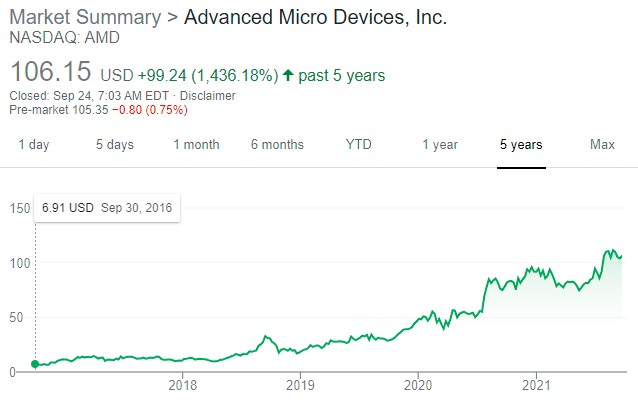How to buy AMD stocks in 2025

Advanced Micro Devices Inc. (AMD) is an American semiconductor company headquartered in Santa Clara, California, United States. The company manufactures CPUs, GPUs, game console products, microprocessors, motherboard chipsets, solid-state drives, network interface controllers, TV accessories, and more. Its stock is listed on the Nasdaq exchange under ticker AMD and is a component of Nasdaq-100 and S&P 500 indices. Intel and NVIDIA are the main competitors of the company; Intel competes with it in the microprocessors market and NVIDIA in the GPU market. At the time of the writing, the company has a market capitalization of $126 billion.
The article guides you on how to buy AMD stock, provides in-depth important information about the company, and analyzes its main fundamental metrics.
How to Buy AMD Stocks in 5 Easy Steps
-
1Visit eToro through the link below and sign up by entering your details in the required fields.
-
2Provide all your personal data and fill out a basic questionnaire for informational purposes.
-
3Click 'Deposit', choose your favourite payment method and follow the instructions to fund your account.
-
4Search for your favourite stock and see the main stats. Once you're ready to invest, click on 'Trade'.
-
5Enter the amount you want to invest and configure your trade to buy the stock.
Top 3 Brokers to Invest in AMD
1. eToro
There are several reasons why eToro has won a spot on our list and has been heralded as having a large market share of traders. Thanks to its consistency over the years, eToro has gained the trust and loyalty of over 17 million users. You can read our full eToro review here.

Security and Privacy
Security and privacy are arguably the most important factors that determine your choice of a brokerage platform. eToro takes the privacy and security of its users very seriously. The platform adopts a thorough security procedure with fewer odds of loss or leakage of information. eToro is regulated by the Cyprus Securities and Exchange Commission (CySEC) and the Financial Conduct Authority (FCA). The platform also adopts the two-factor authentication (2FA) method and uses SSL encryption to prevent security breaches.
Fees & Features
eToro operates a no-commission policy for deposits. However, to promote active trades on the platform, users are charged a monthly fee of £10 for the inactivity fee.
eToro offers a wide scope of offering cuts across several markets, including forex, stocks, and cryptocurrency, aiding an all-in-one trading experience.
Being a beginner-friendly platform, it offers the copy trading feature to help beginner traders leverage the advanced trading strategies used by expert traders. The platform itself also offers winning strategies to guide trade.
| Fee Type | Cost |
| Commission Fee | 0% |
| Deposit Fee | £0 |
| Withdrawal Fee | £5 |
| Inactivity Fee | £10 (monthly) |
Pros
- Copy trading feature
- Ease of use for both new and experienced traders
- Operation across different financial markets
- No commission fee policy
Cons
- Customer service offerings are limited.
2. Capital.com
Capital.com is a reputable brokerage that supports trading on several financial markets. The provisions of its trading terms and the quality of innovation and efficiency of operation offered through the platform's features have granted it a market share of over 5 million users. Other benefits of the platform are no commission, low overnight fees, and tight spreads. You can read our full Capital.com review here.

Security and Privacy
Accredited by financial regulatory bodies including the FCA, CySEC, ASIC, and the FSA, Capital.com adheres to industry security guidelines in protecting its users. In addition, the platform complies with PCI Data Security Standards to safeguard customers’ information.
Fees & Features
Capital.com is popular for its offer of free brokerage services. With no hidden charges, inactivity charges, or withdrawal charges, Capital.com operates a transparent fee procedure. The bulk of the fees charged by Capital.com are Spread charges.
Capital.com’s mobile trading app has an AI-powered tool that provides clients with personalized transformation through its detection algorithm. In addition, the platform has an efficient and responsive customer support team serving multilingual customers via email, phone calls, and live chat channels round the clock.
| Fee Type | Cost |
| Commission Fee | 0% |
| Deposit Fee | £0 |
| Withdrawal Fee | £0 |
| Inactivity Fee | £0 |
Pros
- Responsive customer support team
- Ease of use with the MetaTrader integration
- Commission-free trading policy
Cons
- CFDs restrictions.
3. Skilling
For a broker that originated in 2016, Skilling’s journey to the top has been impressive. The platform offers services across multiple asset trades, serves advanced trading strategies to experienced traders, and offers commission-free services. You can read our full Skilling review here.

Security and Privacy
Skilling is regulated and accountable to highly reputable financial regulatory bodies like the FSA and CySEC. In addition, the platform maintains a different bank account for monies paid by traders to enhance the security of funds.
Fees & Features
Skilling, like eToro and Capital.com, offers commission-free services. The fees are charged as Spreads and vary based on share type. Another upside to trading on Skilling is flexibility and choice. The platform offers two varieties of accounts for trading CFDs on forex and metals. The first is the Standard Skilling account with bigger spreads and no commissions. In contrast, the Premium account offers reduced spreads and charges commissions on spot metal and forex CFD trades. In addition, Skilling offers features such as a demo account, mobile apps, and a trade assistant.
| Fee Type | Cost |
| Commission Fee | 0% |
| Deposit Fee | £0 |
| Withdrawal Fee | No fixed cost |
| Inactivity Fee | £0 |
Pros
- No-commission fee policy
- Responsive support team
Cons
- Technical for novice traders
- Service unavailable in countries such as U.S and Canada.
Everything You Need To Know About AMD
Before investing in AMD, you should know its history, business strategy, revenue sources, and past performance. Informed investors are more likely to make correct investment decisions than uninformed investors who base their decisions on shallow knowledge or hearsay.
AMD History
American electrical engineer and businessman Jerry Sanders founded AMD on May 1, 1969. Initially, the company acquired a second source license to manufacture and sell microchips originally developed by semiconductor company Fairchild Semiconductor, to earn revenue and build its customer base. In the same year, the company developed its first product, Am 9300, a 4-bit integrated circuit shift register. The company’s foray into the RAM chip market began in 1971 when it developed its 64-bit bipolar RAM, the Am3101.
On September 27, 1972, AMD launched its IPO by issuing 620,000 common stock shares on the over-the-counter market at $15.50 per share, raising $7.5 million from the offering. The company entered the microprocessor market in 1975 by manufacturing its first CPU, named Am9080. In 1977, German engineering and technology company Siemens purchased a 20% stake in AMD and initiated a joint venture to enter the American market. As a result of the joint venture, AMD stepped into the microcomputer manufacturing field as well. However, the venture ended in 1979 when AMD bought back Siemens’ stake and divested the joint company Advanced Micro Computers (AMC).
Its stock got listed on the New York Stock Exchange (NYSE) in 1979. Intel and AMD signed a 10-year technology exchange agreement in October 1981 for manufacturing Intel’s x86 processors for IBM PCs. Later the company began producing intel-licensed 80188, 8086, 80186, processors as well.
In 2003, AMD first divested its flash memory business by entering into a joint venture with Fujitsu and created a company called Spansion. However, AMD divested its share of the company in 2005 to focus on its microprocessor business. In 2006, the company acquired ATI Technologies, a graphics processor manufacturer, for approximately $5.4 billion. The company will complete its acquisition of Xilinx, a programmable logic device manufacturer, by the end of 2021 for $35 billion.
What Is AMD’s Strategy?
AMD focuses on using high-performance technologies to develop high-performance products. As part of its strategy, the company focuses on high-performance graphics, such as gaming, console gaming, cloud gaming, computing, artificial intelligence, and virtual & augmented reality. AMD’s management believes graphics will drive the growth in high-performance technologies in the years to come.
AI, big data analytics, visualization, and gaming all require high-performance computing, and the company is developing products using its strengths, thanks to its strategic investments to develop Zen computer processor microarchitecture and new graphics architecture with RDNA.
AMD’s management aims to further expand its market share across PCs, gaming and data centres, which will drive the revenue and deliver returns to shareholders. The management has a long-term target model of accelerating the financial momentum by improving gross margins, increasing profitability, and generating significant cash from its core business activities.
How Does AMD Make Money?
AMD divides its revenues into two segments: The Computing and Graphics segment, and the Enterprise, Embedded and Semi-Custom segment. The revenue earned by its Computing and Graphics segment includes sales of desktop and notebook microprocessors, accelerated processing units, discrete graphics processing units (GPUs), chipsets, data centre & professional GPUs, and development services. The main revenue-generating products in the segment in Q2 2021 were AMD Instinct GPUs and Radeon 6000 series.
The Enterprise, Embedded and Semi-Custom segment includes sales of server and embedded processors, development services, semi-custom System-on-Chip (SoC) products, and technology for game consoles. The main revenue-generating products in the segment in Q2 2021 were semi-custom product sales and EPYC processors.
How Has AMD Performed in Recent Years?
AMD stock has been rising steadily since late 2016 and is near its all-time high of $118.77 as depicted in the following chart. It generated a cumulative return of 1,436% for the past five years between September 2016 and September 2021.

Source: Google Finance
Where Can You Buy AMD Stock?
You can buy AMD stock by opening an account with a stockbroker. The most common types of accounts offered by stockbrokers are cash account, margin or leveraged account, and other specialized investment accounts. With a cash account, you can only buy shares using the amount of cash in your trading account. A margin account, on the other hand, allows you to borrow money from your stockbroker to open large trades. However, margin or leveraged trading involves risk and is not suitable for long-term investing.
AMD Fundamental Analysis
Investors use fundamental analysis to determine the intrinsic or fair value of a stock with respect to its market price. There are plenty of metrics that you can use to analyze a stock, but the most common ones used by investors are P/E, revenue, earnings, earnings-per-share, dividend yield, and cash flow.
AMD’s Revenue
The revenue of a company denotes the amount of money generated by the sales of its products or services in a particular period. Companies that report healthy growth in their revenues consistently are more likely to generate higher profits, market share, and cash flows. You can find the revenue figure on the Income Statement that is issued as part of the financial statement covering a particular period, usually quarterly, half-yearly, and annually.
In Q2 2021, AMD reported revenue of $3.85 billion compared to $1.93 billion in the same quarter of the previous year.
AMD’s Earnings-per-Share
The earnings per share or EPS metric represents the amount of net profit available for each share. The measure is calculated by dividing the net profit after deducting dividends paid out to the preferred stockholders and dividing the result by the average number of common shares outstanding. This differs from diluted EPS, which is calculated by including the convertible securities, such as employee stock options and convertible shares, in the average number of shares or denominator. The resulting figure is diluted because of the increase in the denominator.
For example: If a company has a net profit of $100 million and its average number of common shares outstanding stands at 10 million, the stock’s EPS would be $10 per share. In other words, if the company is to distribute its profit, shareholders would receive $10 for each share provided the company has the required amount of cash available.
In its Q1 2021 report, the company reported diluted earnings per share of $0.58.
AMD’s P/E Ratio
The price-to-earnings ratio measures the share price of a stock in relation to its earnings per share. The metric calculates the multiples in which the stock is trading compared to its earnings per share. For example, a stock with a P/E ratio of 10x shows that its market price is 10 times the earnings per share figure. The P/E ratio can be calculated by dividing the share’s market price by its EPS.
The figure is reported on a trailing 12-month basis, which means that the stock’s previous 12-month earnings are summed and divided by the stock’s market price. As of September 24, 2021, the TTM P/E ratio of AMD stood at 37.89x.
AMD’s Dividend Yield
Dividends are cash payments by a company to its shareholders from the accumulated profits of the company. The dividends are paid on a per-share basis and are declared by the board of directors of the company as and when they deem fit. If a company declares to pay dividends, you need to hold the shares before the ex-dividend date to be eligible for dividends.
Dividend yield determines the percentage of the stock’s current price that is paid out as dividends annually. For example, if a stock is trading at $50 and the company pays out $5 in dividends annually, the dividend yield would be 10%. This means that the stock paid out 10% of the stock’s current price as dividends in the past year. You can calculate the dividend yield by dividing the annual dividends per share paid by the share’s market price. Stocks with high dividend yield give you a high return on investment, but the figure can also give you misleading results as the dividend yield depends on the current market price, which can change. If the stock price has recently diminished, the dividend yield will look inflated, giving you the false impression that the stock is attractive for investment.
As of September 2021, AMD has not been paid any dividends since its inception.
AMD’s Cash Flow
The free cash flow represents the amount of cash available after deducing cash for operating expenses and capital expenditures. The metric is calculated by subtracting capital expenditures from the company’s cash flows from operating activities. This differs from the cash & cash equivalent position that is reported on the Cash Flow Statement.
As of June 26, 2021, AMD had a free cash flow of $888 million.
Why Buy AMD Stock?
AMD is a high-growth company that can provide investors with a high return on their investments. Here are some of the reasons why you should buy AMD stock:
- The company has been recording continuous growth in its revenues: the revenue grew 99% year over year in Q2 2021, which shows strong demand for its products.
- AMD doubled its operating margin and tripled its profitability year over year in Q2 2021. The management expects its 2021 annual revenue to increase by 60% year over year due to the robust demand for its products, which can further lift AMD’s stock.
- The stock has been rising consistently since 2016, which is a testament to the company’s outstanding performance as it emerged as a big player in the semiconductor industry.
Expert Tip on Buying AMD Stock
“ AMD stock has been frequently hitting new highs, which might lead some investors to think that the stock may be overvalued. You should compare fundamental metrics of AMD stock with other stocks in the industry to determine whether the stock is appropriately valued as compared to its peers. Also consider buying the stock in small quantities periodically on dips instead of buying large quantities at once, to lower your average cost of holding the stock. ”
5 Things to Consider Before You Buy AMD Stock
Here are the five tips you need to follow before you buy AMD stock:
1. Understand the Company
You should understand the business model of the company, management strategies, revenue sources, fundamental metrics, competitive environment, strengths, opportunities, and risks among other factors. You can find most of the information on the company’s annual financial report. By staying informed with the developments in the industry and the company, you can drastically improve your chances of making correct investment decisions.
2. Understand the Basics of Investing
You need to follow the basics principles of investing, which include creating a diversified portfolio that will reduce your investment risk. If you are into short-term trading, you should employ risk management techniques to protect your capital and keep your risk per trade at manageable levels.
3. Carefully Choose Your Broker
Selecting the right broker can affect your trading performance. Ideally, your broker should provide you with access to an advanced trading platform that is accessible from all operating systems, charges low trading fees and spreads, allows you to trade multiple types of assets, and is registered with local regulators to protect your capital from broker default.
4. Decide How Much You Want to Invest
Professional portfolio managers typically spread investments across different stocks, which reduces the portfolio risk. In case one of the stocks fails due to any reason, the other stocks in the portfolio can make up for the loss. Short-term traders should calculate the size of their trade based on the dollar amount of risk they can afford to risk per trade. If you invest all of your money in a single stock or risk all of your money on a single trade, you expose yourself to high risk and can potentially lose all your money if the market goes against you.
5. Decide on a Goal for Your Investment
You should set a reasonable investment goal and then formulate a practical investment strategy to achieve it. If your goal is to achieve market returns, you can construct a portfolio or get exposure to security that mimics the return of the market. Remember, if you set high investment goals, you will have to assume higher risk and vice versa. So, you should set realistic goals, keeping in view your investment horizon, risk tolerance, amount of capital, among others.
The Bottom Line on Buying AMD Stock
AMD operates in an industry with a total addressable market (TAM) of $79 billion. The data centre, PCs, and Gaming markets are worth $35 billion, $32 billion, and $12 billion respectively. In 2021, the company developed some breakthrough products, such as AMD Ryzen and AMD EPYC for high-performance computing, and AMD Radeon and AMD Instinct for high-performance graphics. The company has also been following its computing architecture roadmap and successfully developed Zen, Zen 2, and Zen 3 from 2017 through 2021; and it is working to develop 5nm Zen 4 in 2022. With plenty of innovative and advanced products in its pipeline, AMD looks to give tough times to its competitors and has been successful in its endeavours, as confirmed by the continuous rise in its stock price.
If you want to buy AMD stock, you should open an account with a stockbroker online. You need to fill out an online form and upload your identity documents, which the broker will verify before opening your account. After your account is opened, you can fund your account using any popular deposit method, such as Paypal, credit or debit card, or wire transfer.
If you are still finding an appropriate stock for investment, you can read other guides on our website that have detailed information on hundreds of interesting stocks.
Frequently Asked Questions
-
AMD stock is one of the leading players in the semiconductor industry that has enjoyed tremendous success, particularly between 2010 and 2021. While there are other semiconductor companies such as NVIDIA and Intel, AMD has uniquely positioned itself. Each company devises its own strategies and has its strong and weak points, with unique positions in the competitive landscape. So, the best option is to analyze the fundamentals of each of the companies and compare them with one another to determine which stock is better in the semiconductor industry.
-
AMD is a growing company that spends a significant amount of capital on research and development activities. The management wants to retain and reinvest the earnings in the company to carry out new projects. While the company has not paid any dividends to its shareholders, the stock has appreciated significantly and rewarded investors adequately in this respect.
-
You can trade AMD stock short-term using short-term price charts or by looking for triggers that move the stock in the short term. By analyzing short-term price charts and catalysts, you can capitalize on rapid price movements to generate profits.
-
Investors who have held AMD stock for the past five years, between 2016 and 2021, would have earned a whopping cumulative return of around 1,422%. This shows that AMD stock has the potential of generating high returns for long-term investors.
-
To determine if AMD stock is overvalued, you can analyze different fundamental metrics such as the P/E ratio and PEG ratio, and compare these with its peers in the industry. Just because a stock is trading at its highs does not make it overvalued.
-
AMD divides its revenues into two segments: The Computing and Graphics segment and Enterprise, Embedded and Semi-Custom segment.






